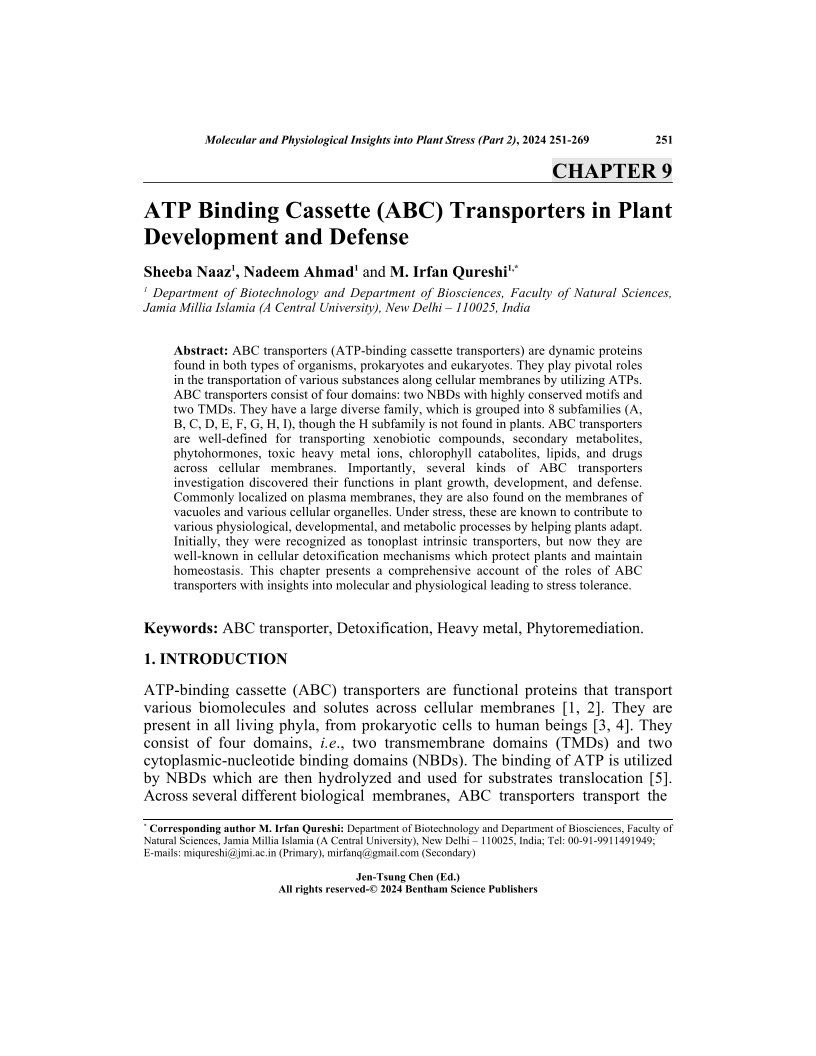ATP Binding Cassette (ABC) Transporters in Plant Development and Defense

- Authors: Sheeba Naaz1, Nadeem Ahmad2, M. Irfan Qureshi3
-
View Affiliations Hide Affiliations1 Department of Biotechnology and Department of Biosciences, Faculty of Natural Sciences, Jamia Millia Islamia (A Central University), New Delhi 110025, India 2 Department of Biotechnology and Department of Biosciences, Faculty of Natural Sciences, Jamia Millia Islamia (A Central University), New Delhi 110025, India 3 Department of Biotechnology and Department of Biosciences, Faculty of Natural Sciences, Jamia Millia Islamia (A Central University), New Delhi 110025, India
- Source: Molecular and Physiological Insights into Plant Stress Tolerance and Applications in Agriculture- Part 2 , pp 251-269
- Publication Date: February 2024
- Language: English
ATP Binding Cassette (ABC) Transporters in Plant Development and Defense, Page 1 of 1
< Previous page | Next page > /docserver/preview/fulltext/9789815179699/chapter-9-1.gif
ABC transporters (ATP-binding cassette transporters) are dynamic proteins found in both types of organisms, prokaryotes and eukaryotes. They play pivotal roles in the transportation of various substances along cellular membranes by utilizing ATPs. ABC transporters consist of four domains: two NBDs with highly conserved motifs and two TMDs. They have a large diverse family, which is grouped into 8 subfamilies (A, B, C, D, E, F, G, H, I), though the H subfamily is not found in plants. ABC transporters are well-defined for transporting xenobiotic compounds, secondary metabolites, phytohormones, toxic heavy metal ions, chlorophyll catabolites, lipids, and drugs across cellular membranes. Importantly, several kinds of ABC transporters investigation discovered their functions in plant growth, development, and defense. Commonly localized on plasma membranes, they are also found on the membranes of vacuoles and various cellular organelles. Under stress, these are known to contribute to various physiological, developmental, and metabolic processes by helping plants adapt. Initially, they were recognized as tonoplast intrinsic transporters, but now they are well-known in cellular detoxification mechanisms which protect plants and maintain homeostasis. This chapter presents a comprehensive account of the roles of ABC transporters with insights into molecular and physiological leading to stress tolerance.
-
From This Site
/content/books/9789815179699.chapter-9dcterms_subject,pub_keyword-contentType:Journal -contentType:Figure -contentType:Table -contentType:SupplementaryData105

